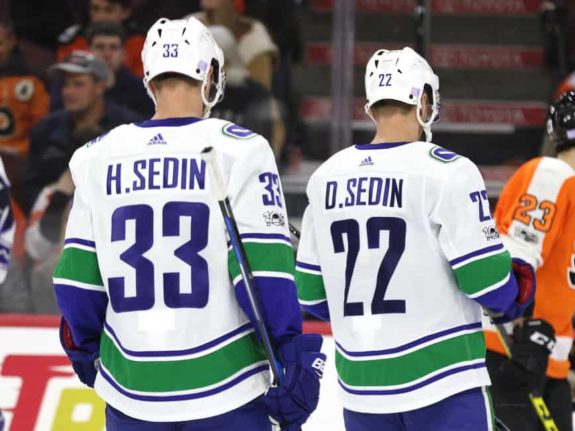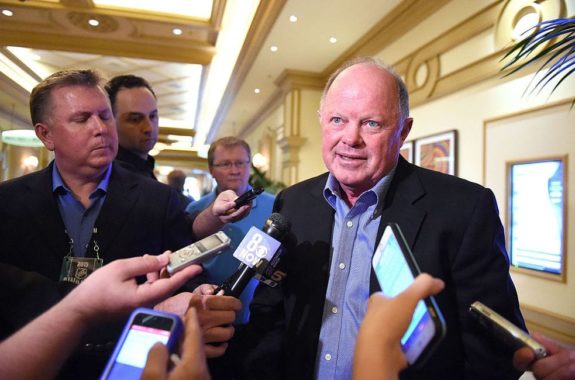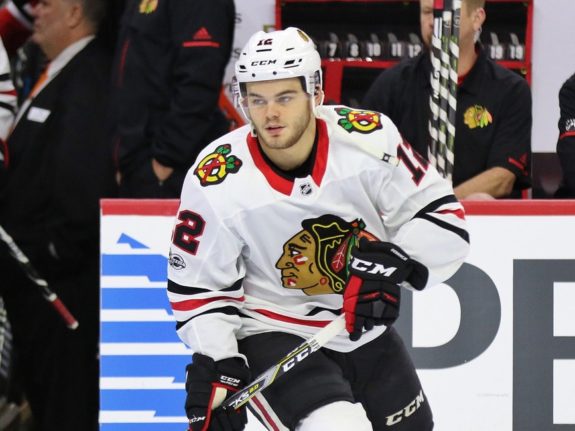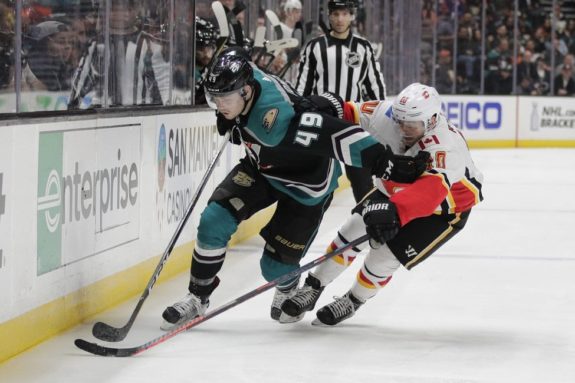Wednesday’s draft lottery did not go as the Anaheim Ducks and their fans wanted. It did go largely as expected, with the Ducks having the eighth-best odds to secure the No. 1 pick or at least a top-three pick. However, instead of obtaining the No. 8 pick, they fell one spot to No. 9. That’s not even the highest pick the Ducks have had in a decade.
In 2012, they drafted Hampus Lindholm No. 6 overall in a season where they finished with the same amount of points that they did this season. Now in position to draft Jack Hughes and Kaapo Kakko, the New Jersey Devils and New York Rangers would be crazy to trade either of their picks. However, the Ducks should still try to trade up, and their target should be the Chicago Blackhawks’ No. 3 pick.
Lottery by the Numbers
As the 2018-19 regular season drew to a close, many Ducks fans hoped the team would lose, thereby increasing their odds to land a top pick in the lottery. Even in the last few games of the season, the Ducks could’ve fallen as low as No. 28 in the overall standings or climbed as high as No. 22. They ended up at No. 25.
When NHL deputy commissioner Bill Daly unveiled the draft order, the Ducks slipped one spot to No. 9.
Anaheim general manager (and former coach) Bob Murray and his players won the final three games of the season and seven of their last 10. With the bottom of the standings so congested, that success put them in the position they’re in now.
There is a solution.
Ducks Should Try to Trade Up
In addition to their own first-round pick at No. 9, the Ducks also have the the first-round pick that they received from the Buffalo Sabres for Brandon Montour. It will likely be somewhere between pick No. 20 and 31 depending on how the St. Louis Blues and San Jose Sharks do in the playoffs.
No matter where that pick lands, the Ducks will have two first-round picks in the 2019 Draft. That makes trading those picks for a higher first-round pick a possibility.
Trading up into the top five spots hasn’t happened lately. The most recent example of a team trading into the top five of the draft occurred in 2008 when the Toronto Maple Leafs traded their first-round pick (No. 7 overall) and a combination of second and third-round draft picks from the 2008 or 2009 drafts to the New York Islanders. With that trade, the Maple Leafs moved from seventh to fifth in the same draft.
Top-Three Pick Trade Frenzy
Trading into the top three happened more often in the late 1990s and early 2000s. In 2003, the Pittsburgh Penguins traded their No. 3 pick and a second-round compensatory pick in the 2003 Draft along with Mikael Samuelsson to the Florida Panthers for their No. 1 pick to select Marc-Andre Fleury. The Panthers had already traded for Roberto Luongo in 2000, so they did not need Fleury.
In 2002, the Columbus Blue Jackets traded their No. 3 pick to the Panthers, for the Panthers’ No. 1 pick so they could select Rick Nash. The Panthers also got the right to swap first-round picks with the Blue Jackets the next season, which didn’t happen because the Blue Jackets finished higher in the standings than Florida in 2003.
In 2001, the Ottawa Senators traded Alexei Yashin to the Islanders for the second pick, Zdeno Chara and Bill Muckalt. They selected Jason Spezza.
Perhaps most notably, the Vancouver Canucks did some significant draft day dealing to secure both Henrik and Daniel Sedin in 1999. They traded Bryan McCabe and their 2000 first-round pick to the Blackhawks for their fourth pick. They then traded that pick and two third-round picks to the Tampa Bay Lightning for the 1999 No. 1 pick.

Still, they weren’t done as they traded that pick to the Atlanta Thrashers for the No. 2 pick and an agreement that the Thrashers would select Patrick Stefan with the first pick. With the No.2 and No. 3 picks, the Canucks selected the Sedin twins back to back.
Bob Murray’s History
Murray typically trades back into the draft to acquire more picks. In 2011, he traded the No. 22 to the Maple Leafs for the No. 30 pick (Rickard Rakell) and the No. 39 pick (John Gibson). He also traded the No. 21 pick to Columbus for the No. 26 (Kyle Palmieri) and No. 37 pick (Matt Clark) in 2009.

The bottom line is that it takes a special circumstance or a foolish team (I’m looking at you, Florida) for a team to trade up into the top three. It’s also very complicated and requires a lot of moving parts like in the case of the Canucks 2000 draft day trade, which is one reason why it hasn’t happened in 16 years.
How Could the Ducks Trade Up?
No trade into the top-three picks has happened in the salary cap era, because teams value the affordability of those high picks more than worrying about future cap troubles.
Before the 2005 lockout, there was no salary cap, meaning lower rookie contracts didn’t have as much value to teams as they do now because those players possess a lot of talent at a very low cap hit.
For example, Connor McDavid’s final season under his entry-level contract was 2017-18. In that season, he had 108 points and his cap hit was $925,000. Starting this season, his cap hit grew to $12.5 million. To say three years of a $12.5 million player at $925,000 is a bargain would be an all-time understatement. That savings is crucial for NHL teams to add high-end talent and stay under the salary cap, especially with a top-three prospect.
In spite of that value, it’s the salary cap that could help the Ducks trade for a higher pick, and I think the Blackhawks are a candidate to trade back in the draft from No. 3. to the Ducks No. 9.
Blackhawks’ Big Contracts
The Blackhawks have more than $26 million of salary cap space tied to three skaters. They owe Patrick Kane, Jonathan Toews and Brent Seabrook $27,875,000 until 2023. In addition, forwards Alex DeBrincat and Dylan Strome will both require raises after next season to go along with Kane and Toews.

Meanwhile, Corey Crawford, Seabrook and Duncan Keith are aging, and Crawford has suffered significant injury problems. Perhaps, as a result, the Blackhawks allowed the second-most goals against in the league in 2018-19. Now would be the time to draft their future replacements (although Chicago did draft goaltender Alex Gravel No. 162 overall last year).
The top of the 2019 Draft is very offense heavy, and the most coveted goalie, Spencer Knight isn’t expected to be drafted until later in the first round at the earliest. The Blackhawks will have potent offensive weapons for a while, meaning they might be motivated to trade back in the draft to draft a young defenseman or even a goalie.
Trading back and acquiring two first-round picks would help potentially spread their future payroll over multiple players while addressing roster needs that they likely could get at the No. 9 spot and another late first round spot.
What Would It Cost Anaheim?
To trade for the No. 3 overall pick, the Ducks will have to pay dearly. We can start at both of their 2019 first-round picks. From there, it would probably require a prospect or two or an established roster player.
The Ducks are aging at center, and Sam Steel has played well to end this season, so he’s out. Troy Terry also showed he could make a significant difference at the NHL level before his injury so losing him would be too high of a price to pay. I’d even struggle trading Max Comtois’ combination of scoring ability and leadership. Max Jones would be the prospect I’d be willing to trade.
Jones is a winger, and the Ducks are better established at that position than at center. Though Jones has shown signs of dominance, he hasn’t shown the offensive finishing ability that Steel, Terry and Comtois have.

If it took any more than that, I wouldn’t trade up, but the Blackhawks may be desperate enough.
The draft lottery didn’t go well for the Ducks, but they could change their fortunes if they approach the Blackhawks with the right trade package. Murray has traded back in the draft before, maybe this season, he’ll change his habits and trade up.